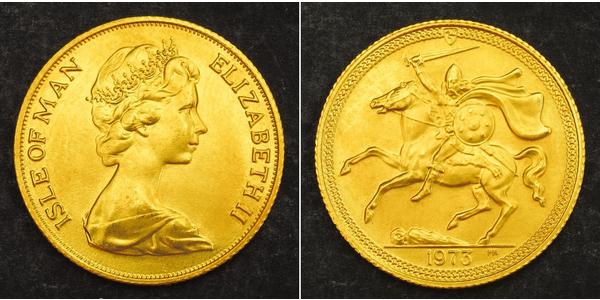(sold for $350.0)
1973, Isle of Man, Queen Elizabeth II. Gold Full Sovereign (Pound) Coin. 8.07gm!
Reference: KM-27. Mintage: 40,000 pcs. Mint Place: Popjoy mint (PM) Denomination: Sovereign (Pound) Mint Year: 1973 (1st-date of issue!) Condition: Brilliant UNCirculated! Material: Gold (.917) Diameter: 22mm Weight: 8.07gm
Obverse: Crowned bust of Queen Elizabeth II right. Legend: ISLE OF MAN - ELIZABETH II
Reverse: Armored medieval Equestrian brandishing sword and holding round shield left. Exergue: 1973 PM
em>.
The Isle of Man (Manx: Ellan Vannin), sometimes referred to simply as Mann (/mæn/; Manx: Mannin [ˈmanɪn]), is a self-governing British Crown dependency in the Irish Sea between Great Britain and Ireland. The head of state is Queen Elizabeth II, who holds the title of Lord of Mann and is represented by a Lieutenant Governor. Defence is the responsibility of the United Kingdom. Insurance and online gambling generate 17% of GNP each, followed by information and communications technology and banking with 9% each. The island has been inhabited since before 6500 BC. Gaelic cultural influence began in the 5th century AD, and the Manx language, a branch of the Gaelic languages, emerged. In 627, Edwin of Northumbria conquered the Isle of Man along with most of Mercia. In the 9th century, Norsemen established the Kingdom of the Isles. Magnus III, King of Norway, was King of Mann and the Isles between 1099 and 1103. In 1266, the island became part of Scotland under the Treaty of Perth, after being ruled by Norway. After a period of alternating rule by the kings of Scotland and England, the island came under the feudal lordship of the English Crown in 1399. The lordship revested into the British Crown in 1765, but the island never became part of the 18th-century Kingdom of Great Britain or its successors the United Kingdom of Great Britain and Irelandand the present-day United Kingdom. It retained its internal self-government.
For centuries, the island's symbol has been the so-called "three legs of Mann" (Manx: Tree Cassyn Vannin), a triskelion of three legs conjoined at the thigh. The Manx triskelion, which dates back with certainty to the late 13th century, is of uncertain origin. It has been suggested that its origin lies in Sicily, an island which has been associated with the triskelion since ancient times.
The symbol appears in the island's official flag and official coat of arms, as well as its currency. The Manx triskelion may be reflected in the island's motto, Latin: Quocunque jeceris stabit, which appears as part of the island's coat of arms. The Latin motto translates into English as "whichever way you throw, it will stand" or "whithersoever you throw it, it will stand". It dates to the late 17th century when it is known to have appeared on the island's coinage. It has also been suggested that the motto originally referred to the poor quality of coinage which was common at the time—as in "however it is tested it will pass".
Only 1$ shipping for each additional item purchased!

|
Posted by:
anonymous 2019-02-23 |
10 Cash China
group has 2 coins
⇑














